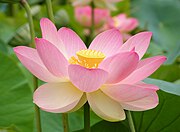Nelumbo nucifera
From Wikipedia, the free encyclopedia
- "Lotus Flower" redirects here. For the upcoming Prince album, see Lotusflow3r.
| Nelumbo nucifera | ||||||||||||||
|---|---|---|---|---|---|---|---|---|---|---|---|---|---|---|
 Nelumbo nucifera flower
|
||||||||||||||
| Scientific classification | ||||||||||||||
|
||||||||||||||
| Binomial name | ||||||||||||||
| Nelumbo nucifera Gaertn. |
||||||||||||||
| Synonyms | ||||||||||||||
|
Nelumbo nucifera, known by a number of names including Indian lotus, sacred lotus, bean of India, or simply lotus. Botanically, Nelumbo nucifera (Gaertn.) may also be referred to by its former names, Nelumbium speciosum (Wild.) or Nymphaea nelumbo. This plant is an aquatic perennial. Under favorable circumstances its seeds may remain viable for many years, with the oldest recorded lotus germination being from that of seeds 1300 years old recovered from a dry lakebed in northeastern China.[1]
A common misconception is referring to the lotus as a water-lily (Nymphaea), an entirely different plant as can be seen from the centre of the flower, which clearly lacks the structure that goes on to form the distinctive circular seed pod in the Nelumbo nucifera. It should also be noted that water-lilies come in colors of white to yellow where as the lotus only in hues of pink.
Native to Greater India and commonly cultivated in water gardens, the lotus is the national flower of India and Vietnam.
Contents |
[edit] Classification
Plant taxonomy systems agree that this flower is in the Nelumbo genus, but disagree as to which family Nelumbo is in, or whether it should be part of its own unique family and order tree. According to the U S Department of Agriculture, water lilies make up the family Nymphaeaceae of the order Nymphaeales.
[edit] Botany
The roots of Nelumbo nucifera are planted in the soil of the pond or river bottom, while the leaves float on top of the water surface. The flowers are usually found on thick stems rising several centimeters above the water. The plant normally grows up to a height of about 150 cm and a horizontal spread of up to 3 meters, but some unverified reports place the height as high as over 5 meters. The leaves may be as large as 60 cm in diameter, while the showy flowers can be up to 20 cm in diameter.
Researchers report that the lotus has the remarkable ability to regulate the temperature of its flowers to within a narrow range just as humans and other warmblooded animals do.[2] Dr. Roger S. Seymour and Dr. Paul Schultze-Motel, physiologists at the University of Adelaide in Australia, found that lotus flowers blooming in the Adelaide Botanic Gardens maintained a temperature of 86 to 95 degrees Fahrenheit, even when the air temperature dropped to 50 degrees. They suspect the flowers may be turning up the heat for the benefit of their coldblooded insect pollinators. The study, published in the journal Nature, is the latest discovery in the esoteric field of heat-producing plants. The very few other species known so far to be able to regulate their temperature include Skunk Cabbage and a Philodendron known as Elephant Ear.
The traditional Sacred Lotus is distantly related to, and possesses similar activity as Nymphaea caerulea. Both Nymphaea caerulea and Nelumbo nucifera contain the alkaloids nuciferine and aporphine.
[edit] Uses
The distinctive dried seed heads, which resemble the spouts of watering cansphoto are widely sold throughout the world for decorative purposes and for dried flower arranging.
The flowers, seeds, young leaves, and "roots" (rhizomes) are all edible. In Asia, the petals are used sometimes for garnish, while the large leaves are used as a wrap for food. In Korea, the leaves and petals are used as a tisane. Yeonkkotcha (연꽃차) is made with dried petals of white lotus and yeonipcha (연잎차) is made with the leaves. The rhizome (called ǒu (藕) in pinyin Chinese, ngau in Cantonese, bhe in Hindi, renkon (レンコン, 蓮根 in Japanese), yeongeun (연근) in Korean is used as a vegetable in soups, deep-fried, stir-fried and braised dishes. Petals, leaves, and rhizome can also all be eaten raw, but there is a risk of parasite transmission (e.g., Fasciolopsis buski): it is therefore recommended that they be cooked before eating.
Lotus rootlets are often pickled with rice vinegar, sugar, chili and/or garlic. It has a crunchy texture or sweet-tangy flavours. In asian cuisine, it's popular with salad, prawns, seasame oil and or coriander leaves.
Lotus roots have been found to be rich in dietary fiber, vitamin C, potassium, thiamin, riboflavin, vitamin B6, phosphorus, copper, and manganese, while very low in saturated fat.[citation needed]
The stamens can be dried and made into a fragrant herbal tea called liánhuā cha (蓮花茶) in Chinese, or (particularly in Vietnam)[citation needed] used to impart a scent to tea leaves. The lotus seeds or nuts (called liánzĭ, 蓮子; or xian liánzĭ, 鲜莲子, in Chinese) are quite versatile, and can be eaten raw or dried and popped like popcorn, phool makhana. They can also be boiled until soft and made into a paste, or boiled with dried longans and rock sugar to make a tong sui (sweet soup). Combined with sugar, lotus seed paste becomes one of the most common ingredient used in pastries such as mooncakes, daifuku, and rice flour pudding.[3]
Various parts of the lotus are also used in traditional Asian herbal medicine.
[edit] Cultural significance

From ancient times the lotus has been a divine symbol in Asian traditions representing sexual purity, a virtue.
Hindus revere it with the gods Vishnu, Brahma, and the goddesses Lakshmi and Sarasvati. Often used as an example of divine beauty, Vishnu is often described as the 'Lotus-Eyed One'. Its unfolding petals suggest the expansion of the soul. The growth of its pure beauty from the mud of its origin holds a benign spiritual promise. Particularly Brahma and Lakshmi, the divinities of potency and wealth, have the lotus symbol associated with them. In Hindu iconography, deities often are depicted with lotus flowers as their seats.
The lotus plant is cited extensively within Puranic and Vedic literature, for example:
| Bhagavad Gita 5.10: |
| One who performs his duty without attachment, surrendering the results unto the Supreme Lord, is unaffected by sinful action, as the lotus is untouched by water. |
This has also taken root in Chinese cultures with a famous statement made by the Confucian scholar Zhou Dunyi:
| I love the lotus because while growing from mud, it is unstained. |
Borrowing from Hinduism, in Buddhist symbolism the lotus again represents purity of the body, speech, and mind as if floating above the muddy waters of attachment and desire. It is also to be noted that most Buddhist, Chinese, Hindu, Japanese, amongst other Asian deities are often are depicted as seated on a lotus flower. According to legend, Gautama Buddha was born with the ability to walk and everywhere he stepped, lotus flowers bloomed.
Drawing in turn on these beliefs, the international Bahá'í community adopted this symbolism in the design of the Lotus Temple in New Delhi, India.
[edit] Other uses
- BJP, a nationalist political party of India which claims to be at the forefront of India's cultural nationalism, uses the lotus as its election symbol.
- Japanese rock musician Miyavi uses the lotus with the kanji of his name (meaning 'elegance'), as his insignia.
- Vietnam Airlines's logo comprises of a golden lotus as is also mentioned in their frequent flyer program, the Golden Lotus Plus.
[edit] Gallery
|
An example of the lotus effect after rain in Kolkata, West Bengal, India. |
|||
|
A lotus field at the Echo Park Lake, with the Los Angeles skyline in the background. |
A lotus field in Hubei province, People's Republic of China |
[edit] See also
| Wikimedia Commons has media related to: Nelumbo nucifera |











